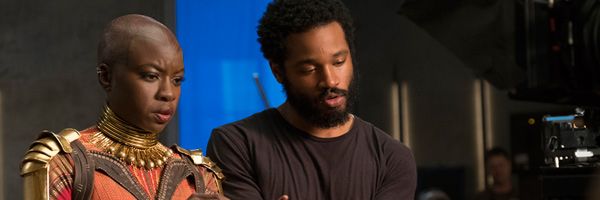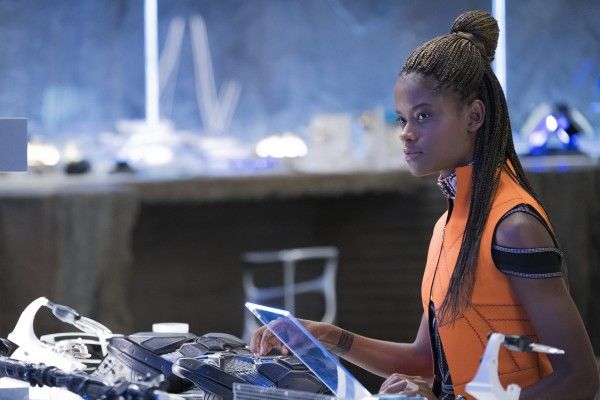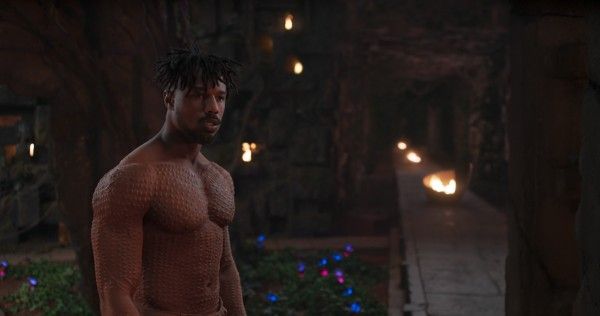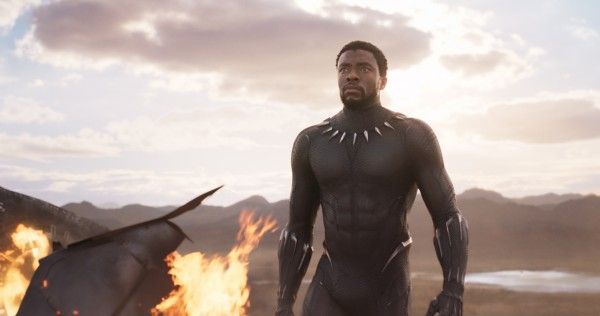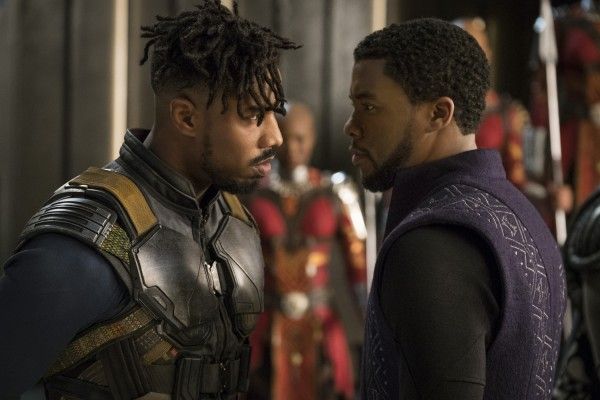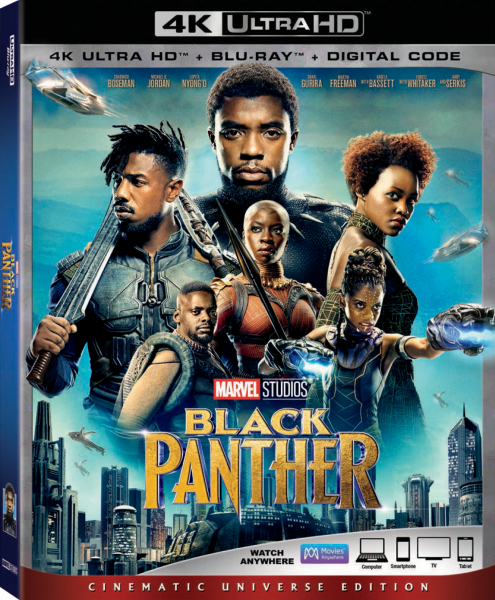Black Panther is hands down one of the best films of 2018, and for the home video release, Disney and Marvel Studios have packed the Blu-ray and Digital HD version of the film with plenty of extras that offer even more insight into how Ryan Coogler’s masterful spin on a “superhero movie” came to fruition. While the Blu-ray includes a number of behind-the-scenes featurettes and even an in-depth roundtable discussion with the filmmakers, as well as a few interesting deleted scenes, the crown jewel is the audio commentary track.
Coogler sits down with the film’s production designer Hannah Beachler and offers a wonderfully insightful, thoughtful, and enjoyable audio commentary track to Black Panther that is chock full of fascinating bits of trivia. The duo talk about everything from Donald and Stephen Glover’s contributions to the film to using color as a theme to reinforce character. The track zips by, and Coogler effortlessly dives into more thoughtful topics of discussion like what it means to be an African-American while also juggling more surface-level topics, like how Shuri’s aware of the “What are those?!” meme.
I highly, highly suggest picking Black Panther up on Blu-ray to take a listen to the track yourself, but below I’ve pulled together a few of the more noteworthy bits of trivia that are gleaned while listening to this audio commentary. This is by no means a complete list and there’s plenty more revealed on the track itself, but this hopefully serves as an interesting toe-dip into just how deep the world of Black Panther really is.
Check out what we learned below. Black Panther is available now on Digital HD and hits 4K Blu-ray, Blu-ray, and DVD on May 15th.
-
The prologue was in and out of the script for a while, before Coogler decided it should be in the movie definitively.
- Production designer Hannah Beachler created a “bible” for Wakanda’s history that was 515 pages long.
- The idea of the basketball hoop made of a milk crate came from Coogler’s idea that Africans the world over create with the tools that they have.
- In writing the script, Coogler realized he had a ton of characters so he wanted to color-coordinate per character and create a color story in which each color tells a story. Purple represents spirituality, royalty, and high rank.
- The color blue in the film represents colonization, which is first seen in N’Jobu’s apartment.
- The first scene introduces the idea that it’s hard to tell where Africans are from, and you can only judge their origin based on how they sound. So they wanted to play with a man talking like he’s from Oakland, then having an African accent, and how fragile it is to be African in different cultures.
- Necklaces also play a big role in the film. In the first scene, all three men are Wakandan royalty and thus all three are wearing gold necklaces. And Killmonger’s father is wearing a herringbone pattern, planting the seed early that he’s Killmonger’s father.
- They had to manipulate the music of the Marvel logo to get it to sync up with the cut from the ship to the logo in a better way.
- The sand tables came about because Coogler wanted to drive home the idea that the tech of Wakanda was tactile, like many things in African cultures.
- A lot of the background plates for the Wakandan exteriors were shot in South Africa, Uganda, and Zambia.
- The museum scene with Killmonger was inspired by an experience Coogler and his wife had at the British Museum themselves, with “odd” interactions.
-
They wanted Klaue to feel like a wildcard, like someone who was dangerous and whose moves you could never predict.
- The waterfall set was 120 feet wide, 40 feet tall, 150,000 gallons of water running through it. Between the two fights, they shot between 12 and 15 days on the set.
- Shuri’s fakeout at the waterfall, when they ask if anyone challenges T’Challa, was suggested by Donald and Stephen Glover.
- Coogler says Spielberg’s Lincoln was an inspiration for the waterfall challenge scene, specifically the political arguments and challenges inside congress.
- They put what Coogler calls a “Jesse James warping effect” on the flashback footage from Captain America: Civil War, with Coogler specifically calling out Roger Deakins’ work on the Western drama.
- Coogler says T’Challa has gotten the herb before and has experienced these visions quests, but this is the first time he’s done it since his father has been dead, so it’s new for him.
- The “What are those?” line came about because they wanted to drive home the idea that Shuri has access to the outside world through the internet, and isn’t closed off.
- Production designer Hannah Beachler says on the commentary track that one of the ways Black Panther stands out is they built a lot of the sets, and used CG only for the background, not the foreground.
- The idea with the Martin Freeman character is that he and T’Challa took care of each other during the events of Civil War, so they trust each other.
- They originally intended to shoot the entire casino action sequence in one shot, but abandoned that idea for impact.
- Black Panther jumping off the car during the Seoul set piece was inspired by athlete Bo Jackson.
- The scene when Killmonger breaks Klaue out is covered in blue, which again represents colonization.
-
Coogler showed a rough cut of the film to Francis Ford Coppola, and as soon as the movie was over the legendary filmmaker asked him to rewind it to “the scene where everything changed,” referring to the scene where T’Challa learns the truth about his father and his past.
- Coogler and his team came up with a backstory for Killmonger’s mother: In the film’s opening scene, Sterling K. Brown’s character is working on a way to break her out of prison. He never does it, and she ends up dying incarcerated, so Killmonger grew up without both parents.
- One of the biggest motifs of the movie is identity, and Coogler points out that the question, “Who are you?” is asked multiple times.
- Coogler says one of T’Challa’s superpowers is that he knows who to trust.
- Coogler connects his own life to Killmonger’s, saying he never thought he’d make it past 30 years old and that short-sightedness is reflected in Michael B. Jordan’s character.
- T’Challa’s “death” is the idea of him paying for sins he didn’t commit.
- The scene between Killmonger and his father references the trials and tribulations of what it means to be African-American.
- Nakia’s costume when they’re going up the mountain was inspired by Harriet Tubman.
- M’Baku’s barking chant was improv’d by Winston Duke on the day of filming.
- Kevin Feige says what M’Baku does is the most honorable thing a character has done in an MCU movie.
- In T’Challa’s second time taking the herb, he sees the men as men and not panthers, because he’s confronting them as humans.
-
In the third act, Coogler says Ross acts as an extension of Shuri. He’s no longer CIA—he’s working with Shuri.
- Killmonger’s line about always being afraid of getting locked up was a suggestion from Coogler’s wife.
- The film’s final scene in Oakland takes place in daytime to contrast it from the beginning. The movie begins and ends with two siblings talking.
- T’Challa goes to the U.N. later, but Coogler says he goes “to the black folks” first, to begin Wakandan outreach to troubled areas.
- The kid that approaches T’Challa is supposed to evoke Killmonger (hence the hairstyle), so T’Challa sees his cousin in this young kid and sees a way to right the wrongs from the past.

